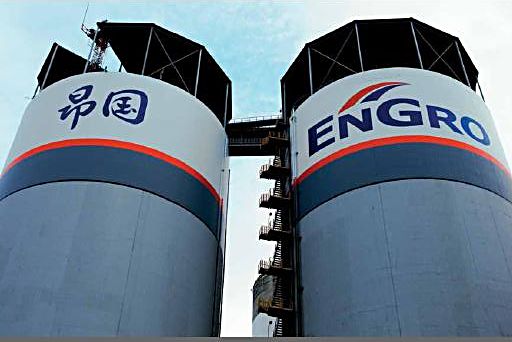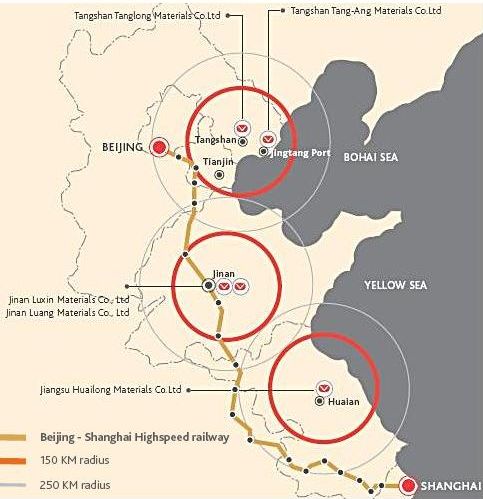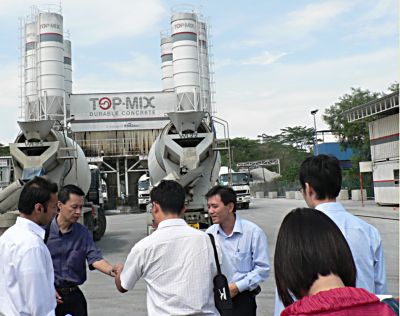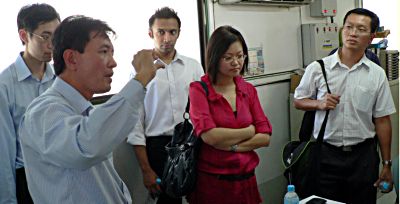 At Jurong Port, EnGro Corp has two silos with a total storage capacity of 60,000 tonnes for specialty cement shipped in from its plants in China. Photo: annual report
At Jurong Port, EnGro Corp has two silos with a total storage capacity of 60,000 tonnes for specialty cement shipped in from its plants in China. Photo: annual reportENGRO CORPORATION is a relatively new name to stock investors but that’s because the company changed its name from Ssangyong Cement in 2005.
The company is, in fact, one of the oldest on the Singapore Exchange, having been listed since 1983, some 10 years after it was formed through a tripartite joint venture by DBS Bank, Ssangyong Cement of South Korea and Afro Asia Shipping.
Cement may be a basic commodity but for EnGro (www.engro-global.com), the excitement going forward is its specialty cement – which can be a one-for-one substitute, by weight, for traditional cement (known in the industry as Ordinary Portland Cement, or OPC) in construction projects.
The specialty cement – which has properties that can extend the lifespan of properties constructed with it to more than 100 years, compared to about 50 years using conventional cement.
Specialty cement - also known as Ground Granulated Blastfurnace Slag (GGBS) - is made from slag, a byproduct generated by steel mills which used to be discarded in landfills in China, with negative impact on the environment.
From being unknown less than 10 years ago, specialty cement has become well-known in the cement industry and there is a long waiting time in some places for it as it is cheaper than traditional cement.
China is one of the leading countries to call for government procurement to go green.
 EnGro's 3 JVs in China to produce specialty cement are close to the route of the Beijing-Shanghai railway being constructed currently. Graphic: annual report
EnGro's 3 JVs in China to produce specialty cement are close to the route of the Beijing-Shanghai railway being constructed currently. Graphic: annual reportGGBS's production generates far less carbon dioxide than traditional cement.
Independent assessments by consultants have highlighted the significantly reduced carbon dioxide emissions by EnGro's GGBS. To be more exact, every tonne of specialty cement saves nearly 1 tonne of carbon dioxide from being generated by the production of 1 tonne of traditional cement.
To see how significant EnGro helps cut back carbon dioxide generation, just consider that in China, EnGro produces 4.2 million tonnes of specialty cement a year, which is a "saving" of roughly 4.2 million tonnes of carbon dioxide.
EnGro, which is one of the largest producers of specialty cement in Asia, has joint ventures in 3 Chinese provinces with 3 top Chinese steel mills whose byproducts (or slag) are funneled to the JVs (40% owned by EnGro) to produce the specialty cement.
”Our business model is highly scalable. We can easily replicate in a short time and when a market has been identified. This can be demonstrated by the 25% compounded annual growth rate of our production capacity in the last 7 years,” said EnGro chairman and CEO Tan Cheng Gay when briefing analysts and fund managers at his office in International Business Park in Jurong East last week.
 Aside from specialty cement, EnGro has a ready-mix concrete business, which analysts and fund managers visited in Tampines. Photo by Leong Chan Teik“We are confident we can maintain this rate of growth in the next five years,” said Mr Tan, attributing the outlook to China’s strong infrastructure programme plus strong GDP growth leading to the emergence of new economic clusters formed through the closer-linked second-tier cities.
Aside from specialty cement, EnGro has a ready-mix concrete business, which analysts and fund managers visited in Tampines. Photo by Leong Chan Teik“We are confident we can maintain this rate of growth in the next five years,” said Mr Tan, attributing the outlook to China’s strong infrastructure programme plus strong GDP growth leading to the emergence of new economic clusters formed through the closer-linked second-tier cities.Not only is the GGBS business highly scalable, but it has been generating a “healthy return on investment,” said Mr Tan.
The demand for traditional cement in China is about 1.56 billion tonnes a year, far exceeding the 60-80 million tonnes a year of specialty cement produced.
“Market demand is not a problem. Every tonne of GGBS we produce is sold,” said Mr Tan, adding that EnGro is supplying to projects such as the 1,318-km Beijing-Shanghai high-speed railway which is expected to consume around 27 million tonnes of cement-based materials before it is completed in 2013.
Under China’s RMB4 trillion stimulus package, investments in railway lines will double to RMB600 billion while RMB5 billion was set aside in 4Q08 to upgrade expressways.
 Eugene Ho (senior manager, Singapore building materials division), explains EnGro's ready-mix concrete operations.
Eugene Ho (senior manager, Singapore building materials division), explains EnGro's ready-mix concrete operations. Photo by Leong Chan TeikEnGro's specialty cement is also used in constructing expressways, tunnels, air and sea ports, urban rail tunnels, among other infrastructure. China's projected spending on infrastructure development over the next two decades will further boost demand for EnGro's specialty cement products.
Another key development in China favouring EnGro is the restructuring and consolidation of steel mill operators to improve efficiency and create internationally competitive steel groups with production capacities of 40-50 million tonnes a year.
As EnGro’s partners expand to form larger steel groups, its supply of slag will offer more investment opportunities.
Mr Tan said that the increasing use of GGBS to replace conventional cement is a global trend, citing Germany as an example where GGBS consumption has overtaken that of conventional cement.
As China strongly promotes the adoption of the latest technology, EnGro is confident that it would not be too long before the same phenomenon is witnessed in China.

